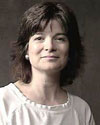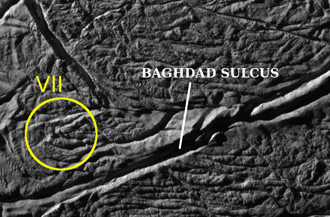 Carolyn Porco
Carolyn Porco
Cassini Imaging Team Leader
I’m very happy to report that we’ve just put one more major milestone in this remarkable adventure successfully behind us.
Another bold dip over the south pole of Enceladus and another skillful setup for imaging the moon ‘on the fly’ have brought us another bounty of positively glorious views of one of the most fabulous places in the solar system.
 On this run, we have captured, by design, jet source regions we didn’t catch the first time: sources VI (see https://www.nasa.gov/mission_pages/cassini/multimedia/pia11134.html )
On this run, we have captured, by design, jet source regions we didn’t catch the first time: sources VI (see https://www.nasa.gov/mission_pages/cassini/multimedia/pia11134.html )
and VII ( see https://www.nasa.gov/mission_pages/cassini/multimedia/pia11127.html ) on and near the Baghdad tiger stripe, and we repeated our imaging of II and III on Damascus. In all, we’ve now seen at very high resolution (tens of meters per pixel) sources I, II, III, V, VI, and VII. (See http://photojournal.jpl.nasa.gov/catalog/?IDNumber=pia08385
for a map of these locales). And of course, as before, we note that the region of the active tiger stripes is finely-fractured throughout and littered with icy blocks.
Our next flyby of Enceladus, as you may know, is not for another year. The sun will be disappearing from the south pole throughout that time, so that by next year we will have a far dimmer view of a shrinking portion of the south polar terrain. So, take your fill of this fabulous place now, because it will be a very, very long time before you see it like this again.
Here are three more images we posted from yesterday’s flyby:
https://www.nasa.gov/mission_pages/cassini/multimedia/pia11125.html
https://www.nasa.gov/mission_pages/cassini/multimedia/pia11124.html
https://www.nasa.gov/mission_pages/cassini/multimedia/pia11108.html

hi to all crews and workers there in NASA especially the astronauts and cosmonauts. Good Day! I’m 13 years old and a girl from Philippines. I really wanted to be an astronaut so I’m trying hard to finish my studies and take up Engineering when I come up with college. I’m hoping that someday, I will be chosen as one of your workers there in NASA especially as one of the space missioners. More Power!
Hi!
How come that even now in 2008, NASA still give us black & white photos? Please, let’s start a world wide collection and buy some decent gears for you guys!
Considering far greater people than I have died unable to even dream of the glorious information NASA provides on a daily basis, it could be a lifetime before I see a different image of enticing Enceladus and I still would not be worthy to complain.
Thank you all for being so professional and inspirational with what you do.
I shudder to think what possibilities may lay beneath the icy percolation of Enceladus. What an eager time to be alive.
Enceladus or Bust!
Can someone please comment on the scale of this image (https://www.nasa.gov/mission_pages/cassini/multimedia/pia11124.html) taken of Enceladus? I can see some relief on the terrain *but* what scale are we talking about here? I mean it looks like series of ridges and valleys but how high or low are they? Are we talking on the scale of the grand canyon on earth or a different scale entirely? Also are these fissures the source of the ice geysers discovered a while back? Is this the place that spews icy material into some of Saturn’s rings?
Thanks,
Juan
Hello, I think you guy’s are so very lucky. Well, OK luck has nothing to do with what you do. You all have done such great work I command you for work you do in the name of Humanity.
I would like to know if NASA works hand in hand with the European community in these type of projects or dose NASA pick what projects that they want to share in.
Do you think that we’ll ever have a World Federation NASA or is it better for NASA stand alone and why.
I know I’m off subject, but what do you expect from an uneducated dummy.
The photo looks so perfect. The complexity of the ridges is shown simple. were there water flowing during pregistoric dates.Why it is named as “Baghdad…”.does it have a connection with something ancient
Congratulations again NASA.
There is soooo much to see and learn from all the current missions that it is difficult to sit still and read in depth what has been achieved.
Dipping in and out I feel guilty because I really should be sucking it all in. I am….honest…but, like I said….soooo much to see and learn and take in.
What a feast….thank you again!
Congratulations on fantastic imaging (albiet B&W) and other-worldly science. A reader’s question regarding scale is valid for us lay people — just what are we looking at in the close-up images? A while back Carolyn was kind enough to explain briefly why we can’t see the actual ice plumes in these remarkable images, but I think readers such as myself would like a more indepth explanation why we aren’t able to see them on these flybys when they are so vivid from afar. I am thrilled to live in a time when the science fiction of my youth has become even more enthralling science fact now.
To NASA and the International Space Station crew
Thank you for voting for McCain
Based on ground based research and Hubble Space Telescope observation it is now apparent that solar system has a tenth major planet and is accompanied by a dark dwarf star.
The tenth planet is an ice giant about the size of Venus in terms of mass: placement is at 20 billion km. Tenth planet may be named Elysium. The planet is orbited by a moon: daughter of Elysium.
The dark dwarf star must be approximately twice the mass of Jupiter and possessing numerous moons and planets. Orbital placement would be
50 billion km from sun. Some of the moons or planets in orbit about dark star would be about the size of Mars and have substantial atmospheres.
spectacular photos of a moon i’ve envisioned for decades of reading sci-fi, but could not possibly have imagined like these images.
cassini team successes just keep on rolling in– well done.
thank you for visions of moons that men have never seen before.
they give us earthlings hope.
j.
I might suggest there is some sort of fusion reaction taking place in the core of this planet. Perhaps the decay of radioactive materials. Find me a better explanation and I am all ears!
Just came across this summary of Enceladus and Titan future mission cost and science value estimates: http://www.planetary.org/blog/article/00000977/
Wow, it takes two decades to get a risky Enceladus plume sample return.
One proposal not mentioned is to wait a few years for instrumentation advances and launch a superior suite of sensor instruments to Enceladus and analyze the sample in situ from the Saturn system after a plume fly-through.
Probably this is considered but no one is projecting spacecraft analytic sensor advances in the next few years. I’m working on the assumption the DoD (and health administrations) will be and are pouring a whole bunch of money into chemical and biosensors, and that these might be transferable to spacecraft sensor suites. Not an expert, but I’d think the main things you’d want to search for in the plume would be the Enceladus equivalent of silica fossils on our sandy beaches. And basic chemistry and any just-vacuumed exo-microscopic life.
Mission #19 takes >18 years but in situ analysis would cut it in half or better, eliminate mission failure risk on the return leg, eliminate cost/fuel of the return to Earth leg. On the downside you’d need to develop new sensor suites now and you lose a lot of analytic ability by not utilizing Earth facilities for sample analysis. I’d bet you could get the mission in under a billion dollars (cheaper if you invent a fraudulent derivatives instrument to fund it). Perhaps the hardest part is the better sensor suite and I’m sweeping that under the table. It can’t be that hard to look for fossils and determine basic chemistry of ice, can it?
I'm a bit late to comment, but agree with the others here that these pictures are much appreciated & fascinating to look at.
I also agree with Sphinx's comment that color pictures would be even better, but assume pics are often in B&W because such image packets are smaller/quicker to transmit back…
But I pop on a pair of those cardboard 3D glasses you get at the movies to view them, and pretend THAT'S what the landscape there looks like! 😉
–
Those are awesome pics!
As a major camera buff, please tell us
what kind of camera is being used,
the film type, shutter speed, etc.
Thank you,
Thank you all for being so professional and inspirational with what you do.
Very good article, very usefull!!
http://www.artezanalnet.com.br/
nice post! id love to go there…even though its kinda impossible! can you show me more please?
These are some incredible images.. thanks for sharing!
| | |
Wow, its really great to see these pictures I can't believe this.
great article. I add this blog on my bookmark.
Thanks for the wonderful post and great links… Very informational and educational!
__
Great info thanks
These are some awesome images! I haven't seen anything like this to be honest.
|
As amazing as the photos look, I cannot ever forget how unforgiving and uninhabitable these places are. Sure, microorganisms may be frozen in time there, but it's no place for man.
Aaron Siegel
TopSavings.Net Telecommunications
Carolyn, these are some great images. Thanks for sharing!
It’s amazing how popular these images and this blog entry remains more than a year after being posted.
The moon is such a majestic beast.
I just stumbled upon your blog and wanted to say that I have really enjoyed reading your blog posts.
I will catch up your updates in future.
Congrats on achieving this milestone, I am proud of you all.
I mean it looks like series of ridges and valleys but how high or low are they? Are we talking on the scale of the grand canyon on earth or a different scale entirely?
Those are some really cool pictures of Baghdad. Which telescope or satellite took these photos? Or is this just thermal imaging…
AMAZING! Great post! Thank you for sharing!
Dear Mrs.Porco,
OMG! I just read your article and it was Fascinating, but even more than that. I looked at your name and picture, and i remember seing you on TV!! I remember it was a Casini Video for…i think it was national geographic, or maybe NOVA. Anyways, i still have the video, (i recorded it) and i remember you were on there and i think the movie was called mission to saturn (?). Oh well, if you dont know which movie i am talking about, probably becuase you were in quite a few, it was the one when Casini just took off and it was featurning the whole mission and how they built casini. It talked about the mistake with the transmission and how the triple doppler effect was used. I remember you commenting at the end of the video when Huigens landed that you were speechless. Hopefullly you can remember which movie i am talking about, out of the many others. I just wanted to tell you that it is SO awesome to be able to blog with you and that i want to be a NASA scientist like you!
Sincerely,
Your middle school fan
I am bit make late to comment, but agree with everyone here that these pictures are much appreciated & fascinating to look at. One thing that color picture would be more appropriate.
I am sorry if I hurt any one.